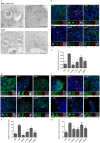Separate domains of G3BP promote efficient clustering of alphavirus replication complexes and recruitment of the translation initiation machinery
- PMID: 31199850
- PMCID: PMC6594655
- DOI: 10.1371/journal.ppat.1007842
Separate domains of G3BP promote efficient clustering of alphavirus replication complexes and recruitment of the translation initiation machinery
Abstract
G3BP-1 and -2 (hereafter referred to as G3BP) are multifunctional RNA-binding proteins involved in stress granule (SG) assembly. Viruses from diverse families target G3BP for recruitment to replication or transcription complexes in order to block SG assembly but also to acquire pro-viral effects via other unknown functions of G3BP. The Old World alphaviruses, including Semliki Forest virus (SFV) and chikungunya virus (CHIKV) recruit G3BP into viral replication complexes, via an interaction between FGDF motifs in the C-terminus of the viral non-structural protein 3 (nsP3) and the NTF2-like domain of G3BP. To study potential proviral roles of G3BP, we used human osteosarcoma (U2OS) cell lines lacking endogenous G3BP generated using CRISPR-Cas9 and reconstituted with a panel of G3BP1 mutants and truncation variants. While SFV replicated with varying efficiency in all cell lines, CHIKV could only replicate in cells expressing G3BP1 variants containing both the NTF2-like and the RGG domains. The ability of SFV to replicate in the absence of G3BP allowed us to study effects of different domains of the protein. We used immunoprecipitation to demonstrate that that both NTF2-like and RGG domains are necessary for the formation a complex between nsP3, G3BP1 and the 40S ribosomal subunit. Electron microscopy of SFV-infected cells revealed that formation of nsP3:G3BP1 complexes via the NTF2-like domain was necessary for clustering of cytopathic vacuoles (CPVs) and that the presence of the RGG domain was necessary for accumulation of electron dense material containing G3BP1 and nsP3 surrounding the CPV clusters. Clustered CPVs also exhibited localised high levels of translation of viral mRNAs as detected by ribopuromycylation staining. These data confirm that G3BP is a ribosomal binding protein and reveal that alphaviral nsP3 uses G3BP to concentrate viral replication complexes and to recruit the translation initiation machinery, promoting the efficient translation of viral mRNAs.
Conflict of interest statement
The authors have declared that no competing interests exist.
Figures







Similar articles
-
Combined structural, biochemical and cellular evidence demonstrates that both FGDF motifs in alphavirus nsP3 are required for efficient replication.Open Biol. 2016 Jul;6(7):160078. doi: 10.1098/rsob.160078. Open Biol. 2016. PMID: 27383630 Free PMC article.
-
Stress granule components G3BP1 and G3BP2 play a proviral role early in Chikungunya virus replication.J Virol. 2015 Apr;89(8):4457-69. doi: 10.1128/JVI.03612-14. Epub 2015 Feb 4. J Virol. 2015. PMID: 25653451 Free PMC article.
-
Role of Chikungunya nsP3 in Regulating G3BP1 Activity, Stress Granule Formation and Drug Efficacy.Arch Med Res. 2021 Jan;52(1):48-57. doi: 10.1016/j.arcmed.2020.10.002. Epub 2020 Oct 31. Arch Med Res. 2021. PMID: 33131924
-
Research Progress on the Structure and Function of G3BP.Front Immunol. 2021 Aug 30;12:718548. doi: 10.3389/fimmu.2021.718548. eCollection 2021. Front Immunol. 2021. PMID: 34526993 Free PMC article. Review.
-
Two Birds With One Stone: RNA Virus Strategies to Manipulate G3BP1 and Other Stress Granule Components.Wiley Interdiscip Rev RNA. 2025 Mar-Apr;16(2):e70005. doi: 10.1002/wrna.70005. Wiley Interdiscip Rev RNA. 2025. PMID: 40170442 Free PMC article. Review.
Cited by
-
Structural and Functional Characterization of Host FHL1 Protein Interaction with Hypervariable Domain of Chikungunya Virus nsP3 Protein.J Virol. 2020 Dec 9;95(1):e01672-20. doi: 10.1128/JVI.01672-20. Print 2020 Dec 9. J Virol. 2020. PMID: 33055253 Free PMC article.
-
RNA-Binding Proteins at the Host-Pathogen Interface Targeting Viral Regulatory Elements.Viruses. 2021 May 21;13(6):952. doi: 10.3390/v13060952. Viruses. 2021. PMID: 34064059 Free PMC article.
-
The Tetraspanin CD81 Is a Host Factor for Chikungunya Virus Replication.mBio. 2022 Jun 28;13(3):e0073122. doi: 10.1128/mbio.00731-22. Epub 2022 May 25. mBio. 2022. PMID: 35612284 Free PMC article.
-
The SHFV nsp2 and nucleocapsid proteins recruit G3BP1 to sites of viral replication, but stress granules are not induced by the infection.J Virol. 2025 Jul 22;99(7):e0079425. doi: 10.1128/jvi.00794-25. Epub 2025 Jun 23. J Virol. 2025. PMID: 40548742 Free PMC article.
-
Activation of the PI3K-AKT Pathway by Old World Alphaviruses.Cells. 2020 Apr 15;9(4):970. doi: 10.3390/cells9040970. Cells. 2020. PMID: 32326388 Free PMC article. Review.
References
Publication types
MeSH terms
Substances
LinkOut - more resources
Full Text Sources
Medical
Miscellaneous

